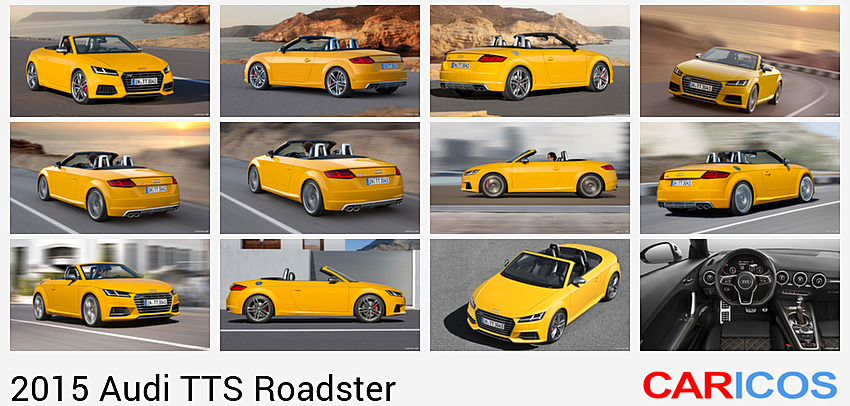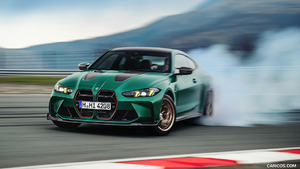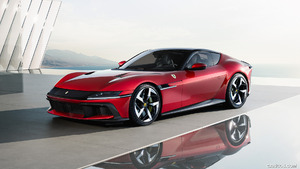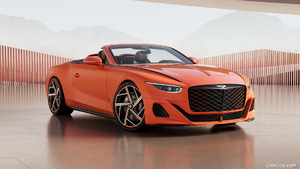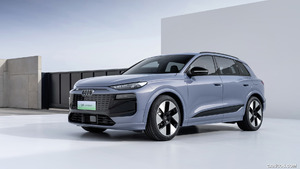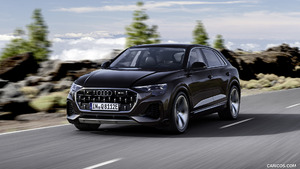Audi TTS Roadster
Purity in its most beautiful form: Audi is presenting the new TT Roadster and the TTS Roadster at the Paris Motor Show. The compact two-seater sets new standards in design, drive, and suspension. A particular highlight in the third TT generation is the Audi virtual cockpit. For the first time, the digital instrument cluster provides all information within the driver’s field of vision – a concept that is causing a sensation. This has already led to the Audi TT’s new display and control system receiving the Car Connectivity Award and the honor of Interior Innovation of the Year at the Automotive Interiors Expo Awards.
Exterior design
The TT* success story began 20 years ago when development of the first model began. Although the original TT debuted as a coupe, the first design model was a roadster. Even then the circle was the central motif – the arcs around the wheel arches at the front and rear were in exciting contrast to the strictly horizontal lines. This timeless architecture quickly earned the TT and TT Roadster a reputation among automobile fans as a design icon – a powerful driver for the further development of the Audi brand.
Just slightly larger than the original TT, the third generation of the TT Roadster also has a powerful and compact road stance. It is 4,177 millimeters (13.7 ft) long and has a wheelbase of 2,505 millimeters (8.2 ft). The overhangs are short. Width and height are 1,832 and 1,355 millimeters (6.0 ft and 4.4 ft), respectively. Compared with its predecessor, the new Roadster is 21 millimeters (0.8 in) shorter and 10 millimeters (0.4 in) narrower. Its wheelbase, however, has grown by 37 millimeters (1.5 in). The TTS Roadster is slightly longer and a little lower. Just how well the new Audi design line has been received by the experts is apparent from two awards the TT Coupé received shortly after its debut. The 2+2-seater was named “Innovation of the Year” in the “Automotive Brand Contest” initiated by the prestigious German Design Council. Shortly thereafter, the compact sports car was honored with the “German Design Award” – which is also sponsored by the German Design Council – in the category “Transportation and Public Design”.
 2015 Audi TTS Roadster
2015 Audi TTS Roadster
Classic: motifs from the original TT Roadster
The Audi designers took up many ideas from the first TT Roadster and refined them. On the flanks these are the muscularly arched shoulders, the light-refracting edge on the sculpted side sills, and the wheel arches, which seem to be superimposed. The front wheel arch intersects the edge of the engine hood, which continues over the door as a shoulder line. At the rear, the lights organically integrated into the design and the side-by-side tailpipes of the exhaust system evoke the original TT.
Above the right rear wheel is the round tank flap, another classic TT feature. The driver opens it by pressing the embossed logo, then inserts the nozzle directly into the opening. As in racing, there is no cap to unscrew.
New facets: the front end
The fusion of typical TT elements with the new, dynamic line results in a progressive design character. With its emphatically horizontal design the front end conveys athletic energy. The small triangles between the Singleframe grille and the headlights are attractive facets. The wide, low grille and the rings on the front hood are reminiscent of the Audi R8 high-performance sports car. Vertical, slightly inclined bars divide the air inlets, and a flat opening below the Singleframe joins them together.
The new TT Roadster comes standard with xenon plus headlights, with LED headlights or Matrix LED headlights available as an option. With the latter, 12 small, individually controllable light-emitting diodes per headlight generate the high beam. The traffic situation is analyzed using a camera on the interior mirror. On the basis of this information, the controller switches the individual diodes on or off, or dims them in 64 steps.
In this way the new headlight system can produce several million light patterns. It prevents other road users from being dazzled by glare and ensures that the road is always brightly illuminated.
In combination with MMI navigation plus, the Matrix LED headlights offer another high-end function: The predictive cornering light is activated on the basis of the route data before the steering wheel is turned.
400 millisecond cycle time: the dynamic turn signals
With the optional headlights, the daytime running lights comprise three bars arranged as a grille. Light-emitting diodes illuminate them via thick-wall optics. The dynamic turn signals are another Audi innovation contributing to road safety. They move with a 400 millisecond cycle time in the direction the driver intends to turn, providing other road users with additional information. In combination with the LED headlights, dynamic turn signals are used in the rear; they are also used up front in combination with the Matrix LED units.
Horizontal lines also underscore the width of the open-topped sports car at the rear. The bars in the standard LED lights, which adopt the motif of the headlights, are permanently illuminated. During strong braking, the adaptive brake light blinks rapidly. The third brake light connects the two units as a strip on the lip of the luggage compartment lid. A diffuser integrates the exhaust tailpipes. At speeds above 120 km/h (74.6 mph), a spoiler extends electrically from the luggage compartment lid to generate downforce on the rear axle.
Even sharper: the S line exterior package
Audi offers the new TT Roadster with the optional S line exterior package, which adds additional sharp accents at the front, on the flanks and at the rear, such as the sportily distinctive air inlets and the aerodynamic side sills. Even more distinctive are the lines of the TTS Roadster, most conspicuously with the chrome-plated housings of the side mirrors and the wide diffuser, which incorporates the four exhaust tailpipes.
The choice of paint finishes is more colorful than before. The solid colors are brilliant black, ibis white and Vegas yellow; the metallic paint finishes floret silver, glacier white, monsoon gray, mythos black, nano gray (new at Audi), scuba blue and tango red (new at Audi).
Daytona gray, pearl effect is available in the S line sport package and with the TTS Roadster. The color Sepang blue and the crystal effect paint finish panther black are reserved for the TTS Roadster.
Soft top
The soft top of the new TT Roadster generation* is an automatic acoustic soft top. It sits low and flows smoothly over the body. The side window is short. If the top loses tension, it is pulled taut again by the two electric motors used to open and close it. There is a choice of three colors – black, gray and beige; the interior color is black.
Like all open-topped cars from Audi, the TT Roadster also has a cloth top. It fits more harmoniously into the design line than a steel roof, and is also much lighter. With its substructure components of magnesium, aluminum, steel and polymer, the soft top weighs just 39 kilograms (86.0 lb), three kilograms (6.6 lb) less than on the previous model. This benefits the total weight and center of mass of the open-topped two-seater.
Space-saving: the Z-fold
While opening, the top forms a Z shape as it folds together into a flat package. Lying in its aluminum compartment, it does not reduce the available volume of the 280-liter (9.9 cu ft) luggage compartment. The standard electric drive opens and closes the top in ten seconds, even when driving at up to around 50 km/h (31.1 mph). Graphics in the Audi virtual cockpit illustrate the procedure. When stopped, drivers can also open and close the TT Roadster with the remote control key if they are not standing more than four meters (13.1 ft) from the car. The thermal and acoustic insulation of the TT Roadster is excellent. The fleece layer above the headlining plays an important role here. The five-layer structure has a total thickness of 15 millimeters (0.6 in) (plus headlining). Interior noise has been reduced compared with the previous model, most noticeably in the frequency range of the slipstream. Options include an electrically retractable wind deflector and headroom heating for the S sport seats.
Body and the lightweight construction concept
The body of the new TT Roadster* and TTS Roadster* represents the latest version of the ASF (Audi Space Frame) technology in a new composite construction of steel and aluminum. It thus follows the classic Audi motto “The right material at the right place for optimal function.”
The substructure uses numerous components from the Volkswagen Group’s Modular Transverse Matrix (MQB), primarily a strong structure of hot-shaped panels in the floor and for the rear longitudinal members. Their extreme strength makes it possible to reduce the cross-sections and thus the weight of the add-on parts, which lowers the center of mass of the entire car.
Large superstructure components, such as the A- and B-pillars and the aluminum sills, are cast nodes and extruded profiles – typical Audi wrought components. The exterior skin and all add-on parts are stamped entirely from aluminum sheet. All together, aluminum and hot-shaped steel in the body-in-white account for 42 percent of the weight.
Maximum safety: targeted reinforcements
Compared with the Coupé, targeted reinforcements have been made to the occupant cell of the Roadster. The side sills, which are produced by means of hydroforming, have interior ribbing of steel. The A-pillars enclose steel pillars, which in turn contain solid steel tubes. V-shaped struts reinforce the zones beneath the engine and luggage compartments and tether the subframes. A solid wall made up of two box sections separates the interior from the luggage compartment. The steel roll-over bars are integrated into the top section of this wall. A through-load facility is inset into the rear wall.
Crash safety is above the level of the previous model. Targeted structural measures enabled the good vibrational comfort of the predecessor to be maintained. The drag coefficient of 0.30 is outstanding. Audi has combined characteristic design with aerodynamics that exceed those of the previous model. Aerodynamic highlights include the front capsule, the aero underbody and the rear spoiler. The vertical bars in the air inlets precisely direct the flow of air to the flanks. In 2.0 TFSI models with manual transmission and front-wheel drive, the lower section of the Singleframe is firmly enclosed.
In the base version with the 2.0 TFSI engine, the TT Roadster has a curb weight (without driver) of just 1,320 kilograms (2,910.1 lb), less than any competing vehicle. The third-generation TTS Roadster, for example, is 25 kilograms (55.1 lb) lighter than its predecessor.
Besides the body, all fields of technology contribute to the weight reduction. The electrical system, for instance, weighs 2.6 kilograms (5.7 lb) less, due in part to a main battery lead of aluminum. The aluminum window lifters save one kilogram (2.2 lb), the new sport seats together save five kilograms (11.0 lb). A lightweight lining for the door panels contributes half-a-kilogram (1.1 lb). In the chassis, the standard 17-inch wheels reduce precisely those unsprung masses that are particularly important when driving. The aluminum brake calipers on the front axle of the TTS Roadster save five kilograms (11.0 lb).
Engines
The new Audi TT Roadster* and TTS Roadster* will launch with two TFSI engines and one TDI clean diesel unit. In keeping with the specifications of the modular transverse platform, all of the engines are installed with the inlet side facing front and inclined twelve degrees to the rear. This allowed the developers to reposition the front suspension much closer to the vehicle’s front end, to the benefit of crash safety and the design.
All three engines are brand-new, two-liter, four-cylinder units with turbocharging and direct fuel injection. They are up to 14 percent more powerful than the engines in the previous model. Fuel consumption of the TTS Roadster was reduced by as much as 15 percent versus the predecessor. Emissions classification for all three is Euro 6. The TDI clean diesel engine and the TFSI engines use similar efficiency measures. First and foremost are the start/stop system, a recuperation system, friction-reducing measures and the innovative thermal management system, which provides highly precise, demand-based regulation of the coolant circuits for the cylinder head and the crankcase. Another feature common to all three engines is a sound actuator, which comes standard along with Audi drive select. If the driving dynamics system (standard on the TTS Roadster, optional on the TT Roadster) is in dynamic mode, the engine sound becomes even sportier.
7.3 seconds from 0 to 100 km/h (62.1 mph): the TT Roadster 2.0 TDI ultra
With 135 kw (184 hp) and 380 Nm (280.3 lb-ft) of torque between 1,750 and 3,250 rpm, the TDI clean diesel accelerates the new TT Roadster from 0 to 100 km/h (62.1 mph) in 7.3 seconds. Top speed is 237 km/h (147.3 mph). Yet in the NEDC cycle, it consumes just 4.3 liters of fuel per 100 kilometers (54.7 US mpg) – that equates to CO2 emissions of 114 grams per kilometers (183.5 g/mi), which is a new benchmark in the sports car world. As a particularly efficient Audi model, the TT Roadster 2.0 TDI bears the “ultra” label. Audi did pioneering work in this field with the previous model, too.
The four-cylinder diesel, whose 1,968 cc displacement is the result of an 81.0 millimeter (3.2 in) bore and 95.5 millimeter (3.8 in) stroke, is a high-tech engine. Two balancer shafts rotate in its crankcase; the intake camshaft in the separate valve drive module can be adjusted by up to 50 degrees of crank angle. The common rail injection system develops a maximum pressure of 2,000 bar. The adjustable vanes of the turbocharger and the compact intercooler in the induction pipe improve throttle response. The exhaust gas after-treatment system integrated into the engine package quickly comes up to operating temperature following a cold start.
Lean and powerful: the 2.0 TFSI
The 2.0 TFSI, which weighs just over 140 kilograms (308.6 lb), is available in two versions – with 169 kW (230 hp) in the new TT Roadster and with 228 kW (310 hp) in the new TTS Roadster. The two-liter engine has received numerous improvements compared with the previous engine, which an international panel of journalists named “Engine of the Year” in its category five years in a row, Virtually the only thing left unchanged is the displacement of 1,984 cc (bore x stroke 82.5 x 92.8 millimeters [3.2 x 3.7 in]).
With both variants, additional indirect injection supplements FSI direct injection under partial load, which reduces emissions. The Audi valvelift system varies the lift of the exhaust valves, thus improving gas exchange. A compact rotating core module for the thermal management system and the exhaust manifold integrated into the cylinder head make major contributions to efficiency. Operation of the turbocharger’s electric bypass valve is extremely fast and precise.
Just 140 grams CO2 per kilometer (225.3 g/mi): the TT Roadster 2.0 TFSI
In the new TT Roadster, the 2.0 TFSI produces 370 Nm (272.9 lb-ft) of torque over a broad range from 1,600 to 4,300 rpm. It accelerates the compact sports car with front-wheel drive and manual transmission from 0 to 100 km/h (62.1 mph) in 6.2 seconds, and on up to an electronically governed top speed of 250 km/h (155.3 mph). NEDC fuel consumption is just 6.0 liters per 100 kilometer (39.2 US mpg), equating to CO2 emissions of 140 grams per kilometer (225.3 g/mi). With the six-speed S tronic and quattro permanent all-wheel drive, the key figures are 5.6 seconds for the standard sprint, top speed is also 250 km/h (155.3 mph), consumption of 6.7 liters per 100 kilometers (35.1 US mpg) and 154 grams CO2 per kilometer (247.8 g/mi).
Powerful sports car: the TTS Roadster
The top model in the model series, the new Audi TTS Roadster, is pushing into the domain of the powerful sports cars. Here the 2.0 TFSI produces 380 Nm (280.3 lb-ft) from 1,800 to 5,700 rpm. With the optional S tronic, the sprint from 0 to 100 km/h (62.1 mph) takes just 4.9 seconds, and the electronically governed top speed of 250 km/h (155.3 mph) is reached quickly. Nonetheless, in the NEDC cycle, the new TTS Roadster consumes just 6.9 liters of fuel per 100 kilometers (34.1 US mpg) with CO2 emissions of 159 grams per kilometer (255.9 g/mi).
The high-performance four-cylinder unit has been modified in key areas: the pistons and connecting rods, the main bearing seats and the main bearing cover in the crankcase, the cylinder head alloy and the valves. With a maximum charge pressure of 1.2 bar, the large turbocharger can compress up to 1,000 kilograms (2,204.6 lb) of air per hour. A high-performance intercooler greatly reduces the air temperature.
The powerful 2.0 TFSI in the TTS Roadster responds closely to the throttle and revs up to 6,800 rpm. In automatic mode of the Audi drive select system, it responds even more directly with brief double-clutching underscoring the change of gears by the optional S tronic. Two sound flaps in the exhaust system open at higher loads and rpm, making the already sonorous sound even fuller.
Transmissions
All engine versions of the open-topped two-seater come standard with a manual six-speed transmission. It has a lightweight magnesium housing and gearshifts are short, light and precise. Audi also offers the highly efficient six-speed S tronic as an option for both TFSI units. As with the manual transmission, its internal gearing features sportily short ratios. The tall top gear helps reduce engine speed and fuel consumption.
The six-speed S tronic switches gears comfortably within just a few hundredths of a second with no perceptible interruption of pulling power. In manual mode, it is controlled via the selector lever or the paddles on the steering wheel. In automatic mode, the position D prioritizes lower rpm for lower fuel consumption; the shift strategy is sportier and engine speed level higher in the characteristic for the position S.
Attractive features: freewheeling and launch control
Another strength of the six-speed S tronic besides the ultra-compact packaging is the fuel-saving freewheeling. It is activated when the Audi drive select system (optional on the TT*, standard on the TTS*) is set to efficiency mode and the driver lets off the accelerator. All TFSI engine versions feature the launch control start program, which enables full acceleration from a standstill with controlled wheel slip.
Like all dual-clutch transmissions, the six-speed S tronic comprises two independent transmission structures operated by two radially arranged multi-plate clutches. Both transmission structures are continuously active, but only one of them is connected to the engine at any one time. The fast shifts are performed by switching the clutches. Every transmission speed is assigned a conventional switching unit, as a result of which it is also possible to change directly from sixth to fourth gear, for instance.
quattro permanent all-wheel drive
quattro permanent all-wheel drive is a powerful unique selling point in the segment for the new TT Roadster* and TTS Roadster*. Many aspects of the quattro technology for transverse-mounted engines have been redesigned for even better dynamics, even greater safety and even more driving pleasure.
The heart of the quattro drivetrain, the electrohydraulically actuated and electronically controlled multi-plate clutch, eliminates the pressure accumulator used in the previous generation, making it 1.4 kilograms (3.1 lb) lighter. To the benefit of the axle load distribution, the clutch is located at the end of the propshaft, in front of the rear axle differential. An electrically driven axial piston pump forces the packages of plates inside the clutch together on demand with a maximum pressure of 38 bar. The higher the oil pressure, the more engine power is transferred steplessly from the front to the rear axle.
To ensure the rapid development of pressure, the pump continuously circulates a certain volume of oil during normal driving. This pre-supply is switched off, however, if is not needed, such as when the driver selects efficiency mode in Audi drive select. Temporarily switching it off reduces CO2 emissions by up to 1.5 grams per kilometer (2.4 g/mi). It is immediately reactivated if the grip level on the road decreases or the driver adopts a sportier driving style.
Oriented toward the driving dynamics: management of the quattro drivetrain
The electronic management of the multi-plate clutch is precisely tailored to the new compact sports car. It works together with torque vectoring, a function of the Electronic Stabilization Control (ESC), and is also networked with the Audi drive select system (standard on the TTS Roadster, optional for the TT Roadster). The controller is strongly oriented on handling parameters such as steering angle.
If Audi drive select is set to dynamic and the ESC is set to Sport, the quattro drivetrain reveals its full dynamic potential. The clutch now transfers a portion of the power from the front to the rear axle upon turn-in. As soon as the driver steps on the accelerator, the forces press the Roadster into the bend – spontaneously, with no initial understeer.
Safe drifts are possible under load on low-friction road surfaces. The front axle straightens out the car when exiting the bend. On dry roads, up to 50 percent of the power is transferred to the rear axle. When the front axle has very little grip, this can be as much as 100 percent.
Chassis
The Audi drive select system, which is optional with the new TT Roadster* and standard with the TTS Roadster*, is the mastermind for dynamic driving. The driver chooses between the modes comfort, auto, dynamic and efficiency as well as individual mode with the push of a button. Audi drive select influences the function of the accelerator and power steering and incorporates multiple auxiliary modules, including the S tronic and quattro drivetrain, the cruise control system, the deluxe automatic air conditioning system, the LED and Matrix LED headlights.
Another component under the control of Audi drive select is the adaptive damping system Audi magnetic ride (standard on the TTS Roadster, optional on the TT Roadster). It uses a special hydrocarbon oil with microscopically small magnetic particles to vary the damping in three stages. In dynamic mode, the system makes the car hug the road more closely. The wheels are precisely braced during cornering, and body roll is largely suppressed – making steering response and handling even more spontaneous. Audi magnetic ride counters body pitch during braking.
Sporty gearing: the progressive steering
The technological expertise behind the new Audi TT Roadster and TTS Roadster also includes the chassis. Major components of the front axle are made of aluminum. The rack of the standard progressive steering is geared so that the ratio changes with the steering angle – somewhat less direct around the center position; very direct when the wheel is turned far.
The electromechanical power assistance harmonizes perfectly with this sporty characteristic, decreasing as speed increases. The progressive steering works in close conjunction with three assistance systems – the standard attention assist and the optional Audi active lane assist and park assist systems.
The rear suspension of the open-topped two-seater uses three steel transverse links and one trailing link in order to absorb the lateral and longitudinal forces separately. Their springs and dampers are separate from one another and respond very precisely. The body is lowered ten millimeters (0.4 in) on the TTS Roadster, with the S line sport package and with Audi magnetic ride.
Just 8.7 kilograms (19.2 lb): the wheels
There are twelve different wheel versions available. The TT Roadster comes standard with 17-inch alloy wheels weighing just 8.7 kilograms (19.2 lb) each. The tires are size 225/50. Audi and quattro GmbH offer 18-, 19- and 20-inch wheels in a variety of designs. Weighing just 10.3 kilograms (22.7 lb) each, the optional 19-inch forged wheels are likewise very light. The TTS Roadster and the S line sport package feature 18-inch wheels with size 245/40 tires.
All tires offer better performance compared with the previous model, yet rolling resistance has been reduced significantly. A tire pressure loss indicator and a repair kit are standard.
The large wheels provide room for powerful brakes. The front discs are internally ventilated and measure between 312 and 338 millimeters (12.3 and 13.3 inches) in diameter, depending on the engine. The TTS Roadster has newly developed aluminum calipers on the front axle, which together weigh five kilograms (11.0 lb) less than the components in the previous model. The calipers are painted black (optionally red) and bear TTS logos. The electromechanical parking brake, another innovation, acts on the rear wheels in all model variants.
Exact handling for everyday sporty driving: the ESC
The likewise newly developed Electronic Stabilization Control (ESC) rounds off the handling characteristics perfectly. During fast cornering, torque vectoring – a software function of the ESC – minimally brakes the inside front wheel (with front-wheel drive) or both inside wheels (with quattro all-wheel drive). This enables both wheels on the axle to transfer more lateral force. Due to the difference in traction forces, the Roadster turns slightly into the corner, making handling even more precise, neutral, sportier and stable.
The ESC leaves the choice to the driver: In Sport mode, the system remains active and enhances driving pleasure. In combination with the quattro drivetrain, it facilitates spontaneous turn-in and controlled drifts via active engagement and light braking interventions when understeering. If the driver pushes the button for longer than three seconds, the ESC turns off completely to allow puristic handling.
Interior
The two-seat interior envelops the driver of the new TT Roadster* and the new TTS Roadster* like a tailored suit. With its high belt line, it comes across as intimate and protective, particularly with the top closed, but never restrictive.
The newly developed sport seats with the integrated head restraints are mounted even lower than in the previous model, and also weigh 5 kilograms (11.0 lb) less. Options include power-adjustable lumbar supports (standard on the TTS Roadster), heated seats and a center armrest. Upon request (standard on the TTS Roadster), Audi offers the slim S sport seats with strongly contoured side bolsters and adjustable seat height. The S sport seats optionally feature an electric mimic diagram along with pneumatic adjustment of the side bolsters.
Modern, smart, clean: the interior design
The design of the interior makes the puristic, modern character of the new TT Roadster and TTS Roadster tangible. Emphasized horizontals convey the impression of generous width. The individual volumes are clearly separated; their surfaces taut and clean; the lines are light and almost seem to float. The taut arcs of the armrests in the door trims correspond with the center tunnel console, which in classic TT style supports the calves.
When viewed from above, the instrument panel resembles the wing of an aircraft. Its middle zone is strongly inclined toward the driver. The round air vents – another TT characteristic – are reminiscent of jet engines. They house all of the air conditioning controls. The controls for the heated seats, temperature, recirculation mode, air flow distribution and air flow strength are located on their axes. With the optional deluxe automatic air conditioning, small displays show the selected settings. The highly precision-manufactured air vents illustrate the demanding requirements that Audi has for the function, design and workmanship of the entire interior.
Center of attention: the driver
The elimination of the traditional air conditioning control unit gave the Audi designers the freedom to implement the instrument panel as part of a slim, elegant architecture. The choice of the Audi virtual cockpit had a similar effect; it assumes the function of the central MMI monitor. The interior of the new Audi TT is entirely focused on the driver, with all of the controls arranged around him.
The three-spoke sport steering wheels have also been redesigned. Their rim is flattened at the bottom, and the broad, open spokes are in aluminum look. In the TTS, the characteristic double seam adorns the rim. There are also differences between the multifunction buttons – four are standard; the plus version (standard on the TTS Roadster) includes 14 buttons and rollers.
New colors and materials: color & trim
The Audi designers also created a new color palette for the interior. The three colors black, rock gray and palomino brown are available for the TT Roadster. The colors black or rotor gray with contrasting stitching are available with the S line sport package and TTS Roadster; express red is available exclusively for the TTS Roadster. In the top model, the surface of the instrument panel features an innovative laser texture, whose honeycomb-like, slightly raised structure comes across as both technological and sporty.
Customers can choose between the standard fine paint finish, metal gray and aluminum (standard on the TTS Roadster and with the S line sport package) in multiple variants for the inlays on the console, the center tunnel and the door pull handles. Individually selectable color accents can be set in additional areas of the interior: on the clasps of the S sport seats, the flanks of the center console and the inner rings of the air vents (standard on the TTS Roadster).
Carefully coordinated: the Audi design selection admiral blue
Particularly discerning customers will find many additional customization options. For the seats, these include covers in Alcantara/leather (standard on the TTS Roadster) and fine Nappa leather specially treated to prevent overheating in the sun, plus two leather packages. The S sport seats are covered in luxurious fine Nappa leather; the center sections feature a diamond pattern. The Audi design selection admiral blue combines coordinated leather colors, alternating contrasting stitching, inlays of dark aluminum, color interior elements and special woven floor mats.
Another alternative is the S line sport package, which immerses the interior entirely in black – or most recently with rotor gray appointments. Its design highlights are the cloth-leather seat upholstery with embossed S logo, extended aluminum look with stainless steel pedals and footrest, the aluminum entry sills with S line logos and the specially designed steering wheel.
Audi virtual cockpit and MMI
The Audi virtual cockpit in the new Audi TT Roadster* and TTS Roadster* sets new standards. Its 12.3-inch TFT display with 1,440 x 540 pixels produces tack sharp, brilliant and high-contrast images. Working in the background is a Tegra 30 chip from cooperation partner NVIDIA.
Driving with the soft top down represents a particular challenge for the Audi virtual cockpit. The digital instrument cluster in the new TT Roadster shines here with a luminous intensity of 800 candelas, twice as much as the previous norm in the automotive industry. Reflections were another challenge. The Audi engineers addressed this by tilting the upper edge of the Audi virtual cockpit toward the driver.
The driver can switch between two interfaces using the “View” button on the multifunction steering wheel. In “Infotainment” mode, a central window dominates the view – it offers a big stage for the navigation map or for lists in the Phone, Radio and Audio areas. The tachometer and speedometer are displayed as small dial instruments on the right and left. In the classic view, the center window is smaller; the instruments are roughly the same size as analog displays. The TTS Roadster features a sporty mode in which a central tachometer dominates the view.
The Audi virtual cockpit provides for the attractive and versatile display of all types of information, from the navigation arrows and dynamic animations to the graphics for the assistance systems. Detailed effects round out the state-of-the-art look. The virtual dial instruments, for example, are rendered 60 times per second so that the needles move absolutely fluidly even under full acceleration. The color design of the display changes as a function of the basic menu.
The Audi virtual cockpit already impressed the experts at its premiere in the TT*. The jury for the “Automotive Interiors Expo Awards 2014” awarded it first place in the category “Interior Innovation of the Year – Production Vehicles”. The world’s best designers, suppliers, innovations and products for interior areas were celebrated at the awards ceremony.
Playfully easy: the new MMI
Just as groundbreaking as the Audi virtual cockpit is the new MMI system in the new Audi TT and the TT Roadster. It reveals its full potential as the top-of-the-line version MMI navigation plus with MMI touch. The terminal on the center tunnel console and its menu structure have been completely redesigned. The result is an operating system with flat hierarchies. As in a modern smartphone, an intelligent, easy-to-use logic replaces branched menu trees, and frequently used functions can be reached in just a few steps.
The focal point of the terminal is the round rotary pushbutton. In combination with the connectivity package or MMI navigation plus, its surface includes the touch-sensitive MMI touch. The touchpad is used for entering characters and multi-finger gestures. Drivers can scroll and zoom just like with their mobile phones. An optical sensor with a sensitivity of one-hundredth of a millimeter monitors the rotary motions of the highly precise dial.
The toggle switches for the most important basic menus Navigation/Map, Phone, Radio and Media are located above the rotary pushbutton. The main menu button and back button are located centrally beneath the dial. The buttons to the left and right of it open intelligently linked function and context menus.
“Where can I get gas?”: MMI search with free text entry and natural speech control
A particular highlight of the new system is MMI search, which is available for all basic menus and like a search engine uses free text entry. It generally answers queries after just a few letters, taking into consideration the car’s current location. When searching for a place to eat, for instance, the driver only has to enter the name of the restaurant and the first letters of the city and a list of hits throughout Europe appears together with the addresses. Searching for songs, albums and radio stations works similarly.
Voice control has also undergone intensive further development so that the system now understands many phrases from everyday language usage. Commands like “I would like to talk to Peter” or “Connect me with Peter” are now sufficient to call a contact. The navigation system also now reacts to natural speech (“Where can I get gas?”, “Take us to the closest Italian restaurant.”). The same applies in the Radio (“Play Radio Galaxy”) and Media (“I would like to listen to music from my iPod.”) areas. The seatbelt microphone provides for good audio quality when using the phone, even when the top is down.
The multifunction steering wheel plus with its buttons and rollers (standard on the TTS Roadster) is another control instrument. Other than touch gestures, the driver can perform the same steps here as with the MMI terminal, all without taking his eyes off the road.
Infotainment and Audi connect
The new Audi TT* is the best-connected car in Germany – this was the conclusion reached for the “Car Connectivity Award” sponsored by the magazines auto motor und sport and Chip. The new TT Roadster* and TTS Roadster* roll off the assembly line with the same technology and same offer structure as the Coupé.
Audi designed the infotainment lineup as a modular system. The connectivity package, for instance, already includes the touch-sensitive touchpad MMI touch. MMI navigation plus with MMI touch tops the range. It uses the second-generation modular infotainment platform with the Tegra 30 graphic process from Audi partner NVIDIA, which constantly coordinates with its counterpart in the Audi virtual cockpit as it goes about its work. With a clock speed of over one gigahertz, the four-core chip can perform more than eight billion computing operations per second. The high-end system is a versatile media center. It offers two card readers, the Audi Music Interface (AMI) for connecting mobile players, a DVD drive, an Aux-in connection and a Bluetooth interface for hands-free telephony and audio streaming. 10 GB of flash storage for music files, eight speakers and a speed limit indicator based on the navigation map round out the spectrum.
Lightning fast Internet: Audi connect with LTE modem
The supplemental module Audi connect connects the open-topped two-seater to the Internet via the super-fast LTE standard. The passenger can freely use the Internet to surf and e-mail on his mobile device via the integrated Wi-Fi hotspot.
For the driver, the system brings the online services from Audi connect on board – from Google Earth and Google Street View, traffic information online and parking space search to Twitter and Facebook. An attractive new service is online updates for the navigation map. With online media streaming, which is also new, the Audi MMI connect app provides a connection to the services Aupeo! and Napster. The music data are transferred via Wi-Fi from the smartphone to the MMI navigation plus and the sound system.
The Audi phone box makes it easy to connect the smartphone to the car. The Audi music interface connects portable media players. Further infotainment modules include tuners for digital radio and television reception, the connectivity package, the media sound package and the Audi sound system.
The optional Bang & Olufsen Sound System drives 12 loudspeakers with 680 watts of power. Rather than small holes, their bezels feature fine grooves. The woofers have anodized aluminum elements bearing the logo of the Danish hi-fi specialists. At night narrow LED light guides emit white light.
Equipment
Sales of the new TT* Roadster and TTS Roadster* have already begun in Germany. Deliveries are scheduled to begin at the end of March 2015. The base price for the 2.0 TFSI is 37,900 euros; the 2.0 TDI lists for 38,700 euros and the TTS Roadster for 52,300 euros.
The list of standard features is generous. Four airbags and the integral head restraint system mitigate the consequences of an accident. The sport seats with integrated head restraints, an ISOFIX anchor point on the passenger seat, the Audi virtual cockpit, the MMI radio with MP3-capable CD player, the xenon plus headlights, the multifunction steering wheel, the progressive steering, the electromechanical parking brake, the start-stop switch and the 17-inch wheels document the high-tech status of the open-topped two-seater.
The range of optional equipment is also extensive. Besides the options already named above, the convenience key, the high-beam assist, the lighting package, the storage and luggage compartment package and the through-loading facility with ski/snowboard bag are worthy of mention. Sporty individualists can choose from the S line exterior package, the S line sport package and the Audi design selection admiral blue.
The driver assistance systems for the new Audi TT Roadster and TTS Roadster are also state of the art. Audi side assist uses radar to check behind the car to help drivers change lanes more safely. Audi active lane assist, standard on models with TFSI engines, uses slight steering interventions to keep the open-topped two-seater in its lane; the park assist with display of surroundings guides it autonomously into and out of parking spaces. Another optional system is the camera-based traffic sign recognition. The attention assist and the multicollision brake assist system are standard.

